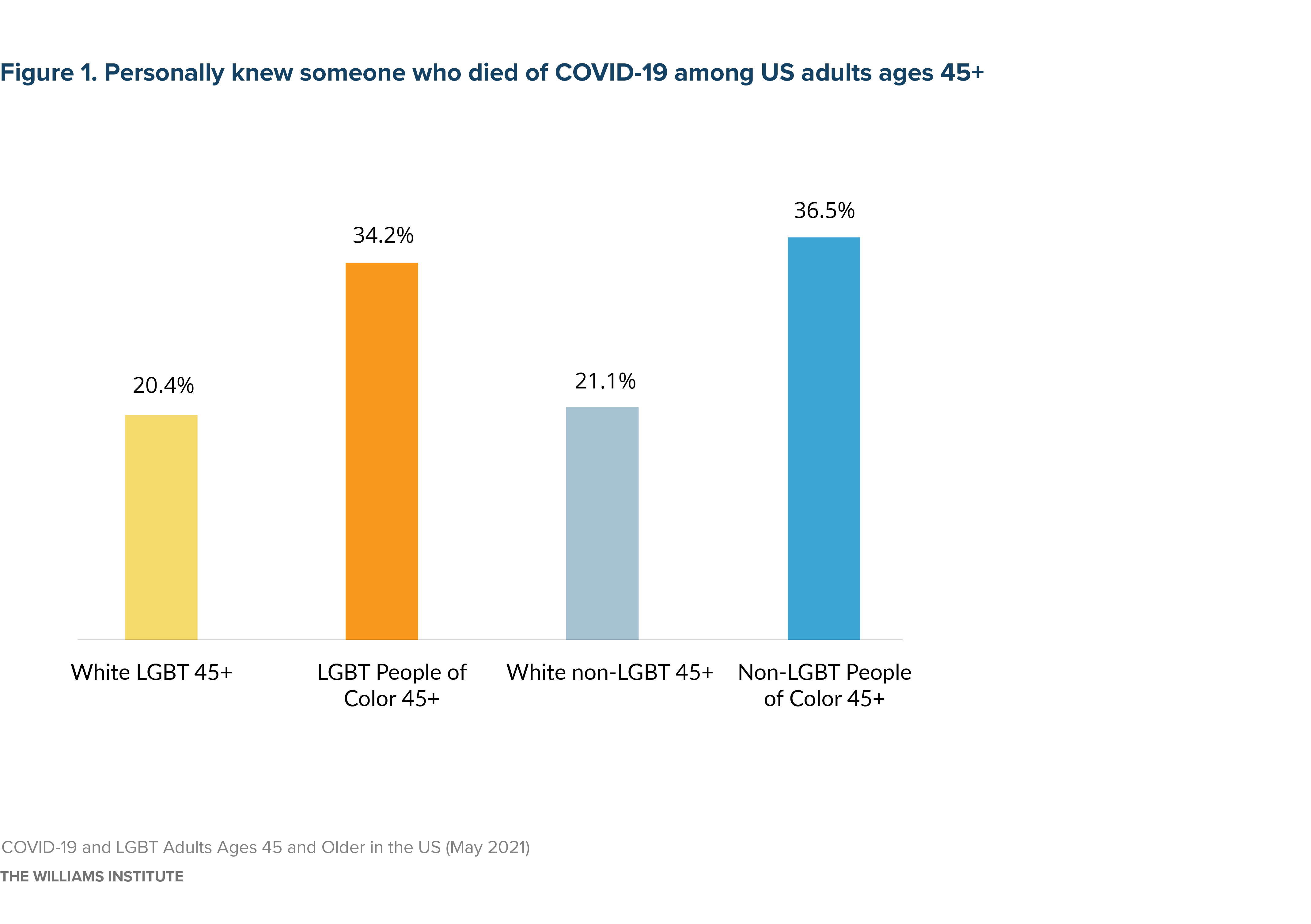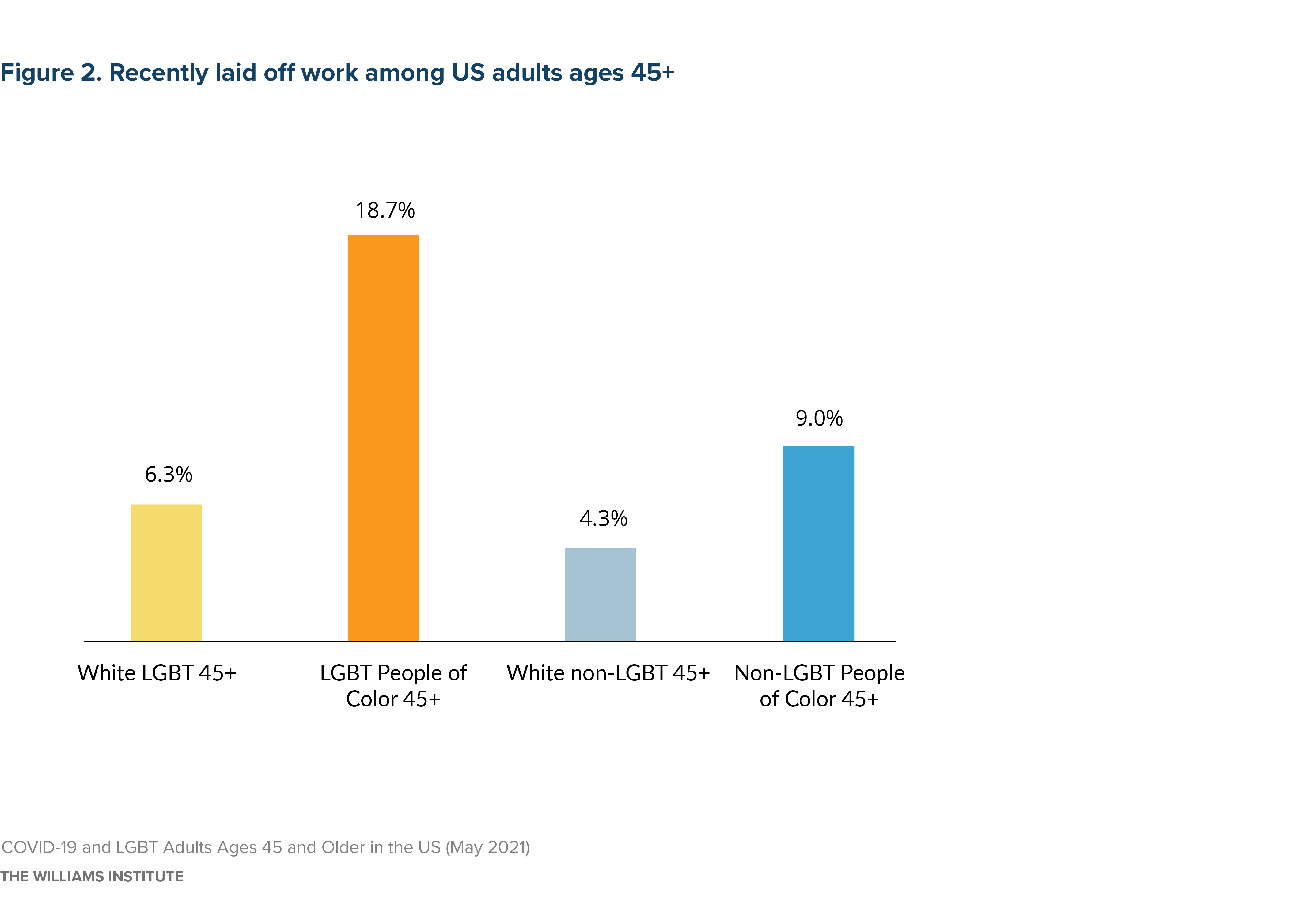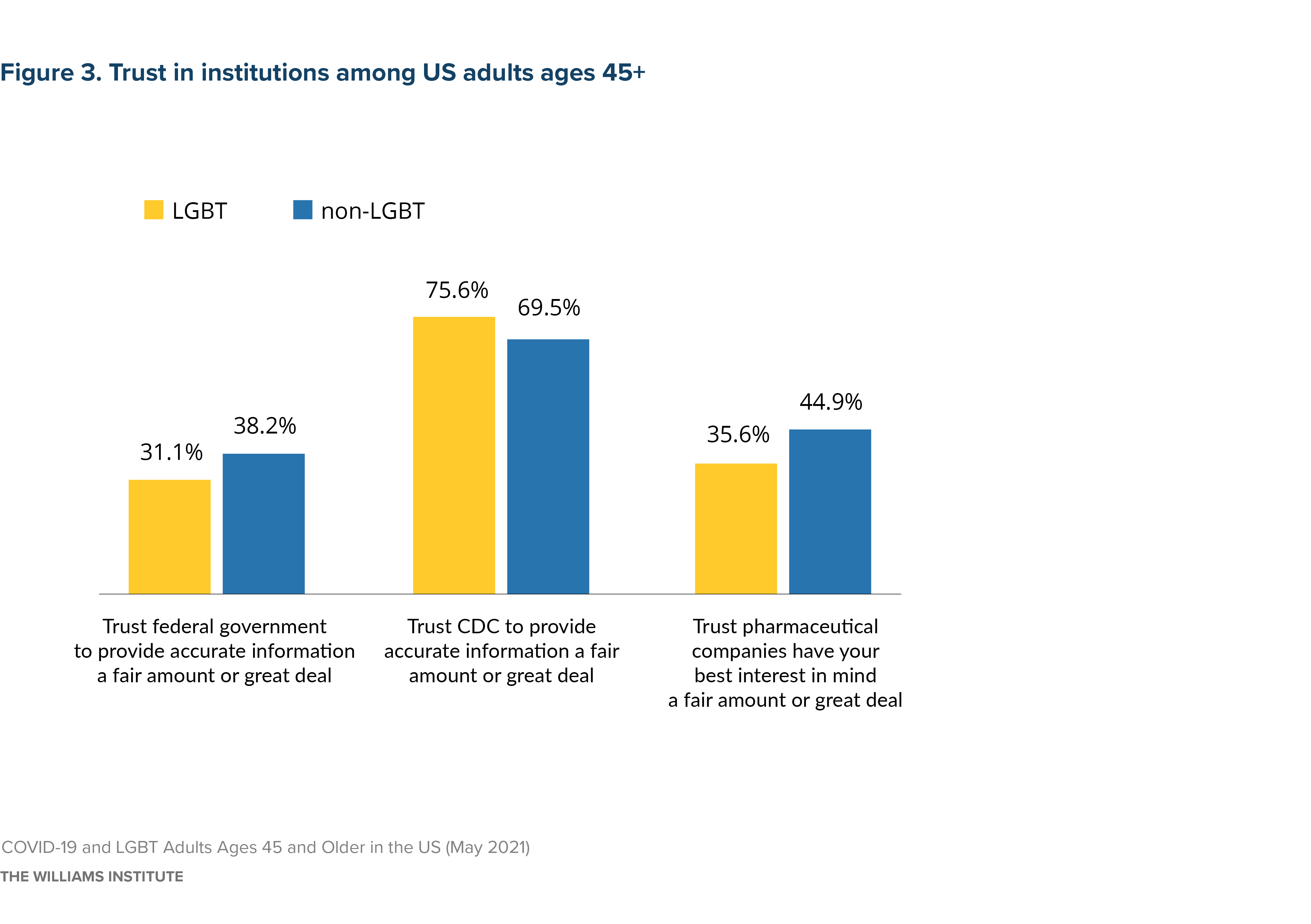Executive Summary
Prior Williams Institute research has shown that many LGBT adults are at higher risk of serious illness related to COVID-19 and its resulting negative economic impacts. This report is a follow up to the March 2021 Williams Institute report The Impact of the Fall 2020 COVID-19 Surge on LGBT Adults in the US and examines the impact of COVID-19 on LGBT people ages 45 and older by comparing their experiences to those of non-LGBT people ages 45 and older, and to those of younger LGBT and non- LGBT people. The report also explores differences related to race and ethnicity among older (those ages 45 and up) LGBT and non-LGBT people.
Drawing upon data collected by Ipsos from a nationally representative sample of over 12,000 adults in the fall of 2020, we find that LGBT people ages 45 and older are more likely to experience the health and economic impacts of the pandemic than non-LGBT people ages 45 and older. Older LGBT people of color, in particular, experience significant disparities in the health and economic impacts of COVID-19 compared to older white non-LGBT people.
Older LGBT people are also more likely to follow recommended public health measures, such as social distancing and wearing masks, and to say they intend to get the vaccine in comparison to younger LGBT people.
Questions that measure respondents’ trust in government and public health officials regarding COVID-19 show that older LGBT people had less trust in the Trump Administration and pharmaceutical companies’ handling of the pandemic and more trust in the U.S. Centers for Disease Control and Prevention, state governments, and other public health officials. With the change to the Biden Administration, restoring trust in institutions leading vaccine administration among older LGBT communities, and in particular older LGBT communities of color, is critical.
Finally, most government data collection efforts focused on COVID-19 do not include sexual orientation and gender identity measures. These omissions, including from the U.S. Census Bureau’s Household Pulse Survey, as well as other state and federal efforts to track deaths and disease more generally, hinder efforts to incorporate the needs of LGBT populations, including older LGBT populations, into COVID-19 recovery efforts.
Key Findings
Health Impacts of COVID-19
- Among those who have tested for COVID-19, positivity rates were similar between LGBT people ages 45 and older (7.9%) and non-LGBT people ages 45 and older (7.5%).
- Of those tested, 12.8% of older LGBT people of color and 5.5% of older white LGBT people had tested positive. Although these numbers suggest that older LGBT people of color may have been more likely to have tested positive, the difference is not statistically significant.
In terms of knowing someone who died of COVID-19, there were differences by race, but not LGBT status. Both older LGBT people of color (34.2%) and older non-LGBT people of color (36.5%) were more likely than older white LGBT people (20.4%) and older white non-LGBT people (21.1%) to personally know someone who died of COVID-19.
Economic Impacts of COVID-19
Older LGBT respondents—particularly older LGBT respondents of color—were more likely to experience job loss and other negative economic impacts related to COVID-19 than older non- LGBT people.
- Older LGBT respondents were more likely than older non-LGBT respondents to have been recently laid off (10.7% v. 5.9%) or furloughed (13.3% v. 9.2%) from their jobs, report problems affording basic household goods (20.6% v. 14.4%), and report having problems paying their rent or mortgage (14.9% v. 8.3%).
- Older LGBT people of color were significantly more likely to experience these hardships than older white LGBT and non-LGBT people, as well as older non-LGBT people of color. Older LGBT people of color were twice as likely to have been laid off as older non-LGBT people of color, and at least three times as likely to have been laid off as older white LGBT and non- LGBT people.
- Older LGBT people of color were also significantly more likely than other groups to report that their ability to afford household goods and to pay their rent or mortgage got worse due to the pandemic. Close to one-third (30.8%) of older LGBT people of color reported that their ability to pay for household goods got worse and one-fourth (24.5%) said their ability to pay their rent or mortgage got worse. They were twice as likely to report these problems as older white LGBT people.
Following Public Health Recommendations & Vaccination
- Older LGBT people (92.8%) were more likely to say they were concerned about the COVID-19 outbreak than older non-LGBT people (84.0%), younger LGBT people (89.0%), and younger non-LGBT people (80.0%).
- Older LGBT people (and non-LGBT people) were more likely to follow recommended public health measures, such as social distancing and wearing a mask, than younger people.
- Similar percentages of older LGBT (54.5%) and older non-LGBT (49.1%) people said they intended to get the COVID-19 vaccine as soon as it became available to them.
- When considering race and ethnicity among older adults, concern about COVID-19 and compliance with public health recommendations were fairly consistent across all groups, with one exception—older white non-LGBT people tended to report lower levels of concern and compliance.
Trust in Government and Public Health Institutions
- During the final months of the Trump Administration, older LGBT respondents were less likely than older non-LGBT respondents to report that they trusted the federal government to provide accurate information about COVID-19 (33.2% v. 40.4%).
- Higher percentages of both older LGBT respondents (66.2%) and older non-LGBT respondents (59.3%) reported that they trusted state governments to provide accurate information about COVID-19 than trusted the federal government.
- Around one-third of older LGBT adults (35.6%) and 44.9% of non-LGBT adults said they trusted pharmaceutical companies to look out for their best interests.
Collected during the COVID-19 surge in the fall and early winter of 2020, these data show differences in how pandemic has been experienced by older LGBT people compared to older non-LGBT people and younger people. In particular, the data show that older LGBT people of color are at increased risk of experiencing economic hardships related to the pandemic.
Policy and other interventions aimed at ending the pandemic and facilitating recovery must address the unique needs of older LGBT people. Specifically, economic recovery efforts must consider older LGBT people—particularly older LGBT people of color—and vaccination efforts must address the built-up distrust in the federal government and pharmaceutical companies among LGBT people in general, including older LGBT people.
Download the full report


